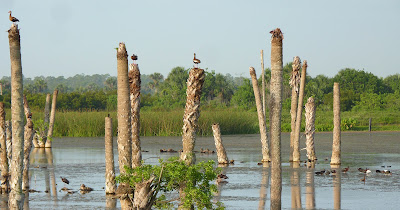The 9th INTECOL International Wetlands Conference brought me down to Orlando, Florida for a week of academic lectures and elbow-rubbing with some of the world's top wetland scientists.
I had been invited to give a 20-minute presentation on my dissertation research (which went great by the way) but I'd be damned if I was going to drive so far south without getting out to see some birds!
So I woke up early one morning and zipped out to
Viera Wetland (aka Ritch Grissom Memorial Wetlands) for some birding appropriate for a wetland scientist.
 |
| Viera Wetland |
The place is a Mecca for wading birds with Ibises everywhere...
 |
White Ibises
|
 |
| Glossy Ibises |
...and a variety of herons...
 |
| Tricolored Heron |
...and egrets...
 |
Cattle Egrets
|
Dozens of Black-bellied Whistlling-Ducks were nesting in hollow palm trunks all over the place.
 |
| Black-bellied Whistling-Duck |
I had only seen these cute guys once before and way down in Panama back in 2008 (ABA bird #338).
The same was essentially true of Roseate Spoonbill, a bird I had seen only once before seen in Nicaragua.
 |
| Roseate Spoonbill |
They look so pretty from far away, but up close the bald head and red eye look downright sinister to me (well if you ignore the comical spoon-shaped bill). This one was my ABA #339!
Least Bitterns were calling everywhere and even a few showed...
 |
| Least Bittern
|
I saw three of them throughout the morning and one was even prowling around on lily pads!
 |
| Hiding in plain view |
I guess it was doing a frog impression? Life bird #1554!
 |
| telescoping neck! |
And then there was a pair of Sandhill Cranes...
 |
| Sandhill Crane |
Just more trash birds by Florida standards!
As you can see the birders in this state are spoiled rotten for cool wetland species. And the photographers who visit Viera Wetland are as well. The site consists of 5 wetland treatment cells, each with a different water level for maximum habitat diversity. And the border of each cell is a high drivable berm. The result is the ultimate lazy nature photographer's dream; simply drive along until you see the right bird in good light and fire away. No need to even leave your vehicle!
The one exception and only time I actually needed to use my scope was when a group of four Crested Caracaras flew along the treeline and landed in a distant pine.
 |
| Crested Caracaras |
Of course it's tough to get a good shot from half a mile away, but I'm always amazed that the birds are even identifiable at that distance. I had seen Crested Caracara's a handful of times in the tropics, but this was my first sighting in the US (ABA #341).
The only bird I was hoping to see and missed was Purple Gallinule. But their "Common" cousins were ubiquitous and I even saw some downy chicks!
 |
| Common Gallinules with chicks |
It took me a few loops around the wetland cells to get my real target bird...
 |
| Limpkin |
...Limpkin! This species looks like it should be a skulker like a rail, but that just isn't the case. Limpkins aren't especially shy, they just aren't very common...
 |
| Yum! Lifer #1555 |
...and only found in areas with an abundance of their prey of choice: snails.
By this point my three hours were up and I had to race back to the convention center for more concurrent sessions and important networking opportunities. But the visit to Viera Wetland was definitely worth the trip. I'm not sure if there is another spot in this area that can offer up such a complete and reliable menu of so many cool species with such great opportunities for photos.
~~
On our way back north Katie and I dropped by Merritt Island National Wildlife Refuge in search of Florida Scrub-Jay, which proved to be easy enough.
The light was terrible for photos, but I was just glad to see this endemic, IUCN-listed species. And I really like Jays.
 |
| Florida Scrubu-Jay |
We also stumbled upon the most cooperative Bobwhite I had ever seen.
 |
| Northern Bobwhite |
We did a little bit of exploring some of the refuge's vast tracts of wetlands and saw some other cool birds such as Wood Stork, Reddish Egret, Black-necked Stilt and more Roseate Spoonbills, but with a 10-hour drive back to Durham looming, we had to cut ourselves off and hit the road.
Hopefully my next trip to Florida will include the Everglades and the plethora of specialties that can be found in the nether regions of the state. But I have certainly had my wetland bird fix for now!
















